Every holiday seems to have its emblematic superstar treat or meal. Valentine's Day is marked by chocolate, and those chalky little hearts that announce loving messages across their faces.
Year after year, candy conversation hearts are exchanged, used in decorations, and bought almost habitually as if Cupid himself endorsed them.
As I perused the aisle full of candy in search of the perfect sweets for my sweets, I began to wonder when the iconic conversation hearts found their way into our traditions and our own hearts.
As it turns out, they have a long sweet history.
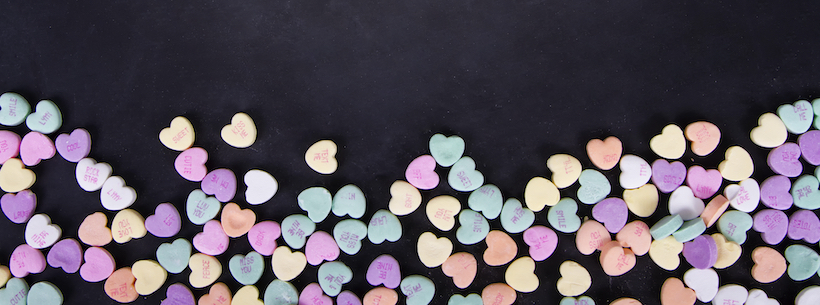
Conversation hearts, also sometimes called sweethearts, are small heart-shaped candies that are popular around Valentine's Day. Each candy piece bears a short printed blurb that can be anywhere from corny to endearing.
Their modern form was perfected by NECCO in 1866 from dough comprised of a mixture of sugar, corn syrup, gelatin, gums, coloring, and flavoring. Once the dough is formed and flavored, it goes through a series of machines to be flattened, cut, and stamped into the recognizable little sweets.
Back in the 1800s, an apothecary lozenge fad was swirling through the land at full-force. These lozenges were created as an effortless – and often sweet – way to administer medicine that was otherwise unpleasant in taste.
They were used to address many health concerns – everything from sore throats to bad breath. Sugar at the time was also thought to have a variety of health benefits. So, if your sweet tooth was calling, the pharmacist was who you wanted to see.
Later, conversation hearts would fulfill those sweet cravings. However, before their inception, another treat would serve as inspiration for the conversational aspect of the candies. Cockles were small candy crisps created by NECCO that were shaped like shells. Within them were tiny slips of colored paper that donned messages such as "Married in satin, love will not be lasting" and "Married in pink, he will take to drink."
Oliver Chase was a pharmacist based out of Boston who saw how profitable getting in on the lozenge market could be.
Oliver Chase recognized how tedious and complicated the process of creating these lozenges was. Appropriately during America's industrial age, in 1847, he came up with the idea for a machine that would streamline this process and allow him to up the production of these lozenges immensely.
This new machine resembled a hand-cranked pasta maker and would quickly roll out, flatten, and cut the lozenge dough into perfect uniform little discs. Today, his invention is considered to be the first American candy-making machine.
Once production picked up, Oliver quickly shifted over to the lacking confectionary business. The company he and his brother Silas Edwin founded, Chase and Company, would merge with three other companies to become New England Confectionary Company. That company in acronym form – NECCO – went on to be one of the more storied candy brands in America.
NECCO would be responsible for making those little hearts into a Valentine's Day icon with a little help from Oliver's brother Daniel. Inspired by the popularity of the crispy cockle's messages, the brothers decided to hand print sayings onto their lozenges.
Then, in 1866, Daniel helped to streamline production once again. He decided to devise a quicker way to add the messages to the candy. From that endeavor came his candy printing machine.
His new invention could press sayings directly onto the lozenge's surface using a felt pad moistened using a red vegetable-based dye.
Initially, the candies were introduced to the public in several different shapes, including clovers and horseshoes.
With the new Valentine's Day holiday growing in popularity, the lozenge shape was changed to a heart in 1902, proving to be exceptionally popular and voila! – conversation hearts were born.
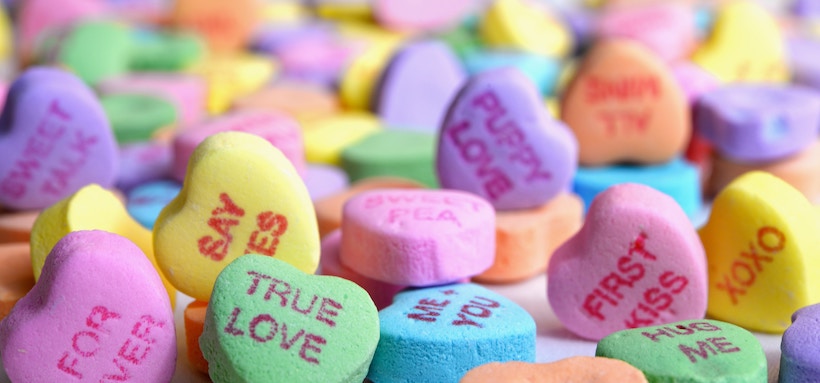
As this sweet treat evolved, so did its name and its popularity. After Daniel invented the machine used to print messages onto the lozenges, the candies came to be known as motto lozenges or motto hearts.
Once the candies morphed into hearts for the holidays, they were lovingly referred to as conversation hearts. It stuck – they've retained that nickname for over a century.
The original form of the conversation hearts, NECCO wafers, and cockles were very well received. So much so that they made their way into historical events:
NECCOs wafers made their transition into small, heart-shaped pieces at the turn of the century. These conversation hearts continued to carve a path leaving their mark and legacy in history.
Over the centuries, Valentine's Day evolved. By the 18th century, it was a tradition in England to exchange gifts and handmade cards decorated with lace, flowers, and ribbon and images of Cupid and hearts. Eventually, these traditions would find their way over to the American colonies.
Esther Howland was attending Mount Holyoke College in Massachusetts. There she received her first English-style valentine. Fascinated by these beautiful cards, she decided to create her own.
The cards became wildly popular in the colonies, and the demand for them was too much for her to handle on her own. And thus, mass-producing valentines became a lucrative career!
With Valentine's Day becoming more celebrated, many believe the Chase brothers (being the visionary entrepreneurs they were) took notice of this growing niche and again found their way into the market. Many speculate that they used the valentines as inspiration, which lead to the motto lozenge's change in shape.
Brightly colored, heart-shaped, sweet, and decorated with sayings that could entice a love interest (and some taste buds)– what could be a better representation of the spirit of the holiday?
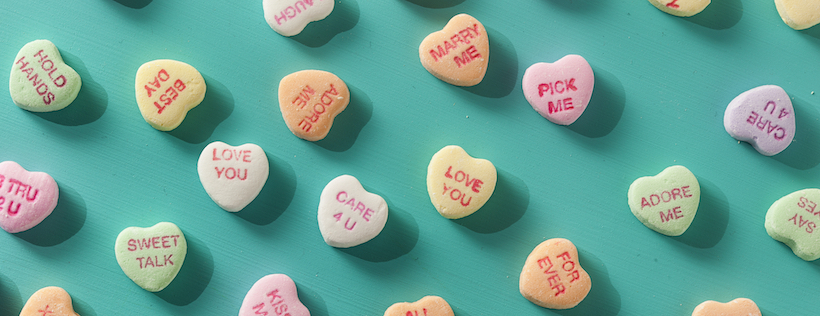
When cockles and wafers were the ones to pronounce their declarations of love and friendship, there was ample space to write lengthy phrases. They were popular amongst wedding parties and dating couples and bore old-fashioned messages such as, "How long shall I have to wait? Please be considerate" and "Please send a lock of your hair by return mail."
Once the large wafers were pared down to their heart-shaped successors, the messages had to be short and sweet. Familiar messages of "Be True," "Marry Me," and "Love" replaced the more detailed sayings.
For a long time, the messages on conversation hearts were a standard set that could be enjoyed year after year. In the 1990s, a vice-president at NECCO came up with the idea to change the sayings to reflect more modern language and trends. Today, each run contains about 60 different mottoes.
The company held meetings annually to discuss which phrases should be swapped out. Any trending expressions are considered for a spot on the candy. As technology shifts, it opens up doors for other unique possibilities. With texting and social media becoming mainstream, acronyms such as LOL and BFF have found their way into the running. Even emojis have been found marking the traditional candies!
When phrases become dated or irrelevant, they are retired and replaced by newer, more relatable buzzwords.
It wasn't until the early 90s when the aforementioned Vice President Walter Marshall came up with the idea of modernizing some of the more out-of-date sayings. The innovative contemporary phrases such as "WWW.CUPID," and "Email Me" were so well received due to the rise in the popularity of the computer that they made news headlines back in 1998.
Particular messages remain popular because of their timeless nature. Thus, you are likely going to see the original mottoes such as Be Mine, sweet talk, and Hug Me for many years to come.
During the 1997 run, "The One I Love" was brought back in celebration of the company's 150th anniversary. This particular motto had not been seen since the early 1900s.
While some mottoes make a comeback, others are gone for good. Trending language such as the retro "Dig Me" and "Groovy", or messages that are nowadays considered unsuitable such as "You are Gay" are not likely going ever to make an appearance again.
The one thing you will never see on a conversation heart is an offensive or mean message. NECCO remained steadfast on this policy and shot down yearly requests for messages like "Get A Prenup" or "Call My Lawyer."
Once in a while, specific message runs didn't turn out as planned. During an interview, one NECCO production manager explained how once in a while, errors occur, making some customers upset. He said there was one year when the hearts had "Smile" printed on them. Unfortunately, they came out a bit sloppy. In response, they received letters from parents who were wondering why "Milf" was chosen as a saying that year.
In some years, the company even opened its exclusive naming rites to the public by allowing them to submit and vote on phrases for the next candy run.
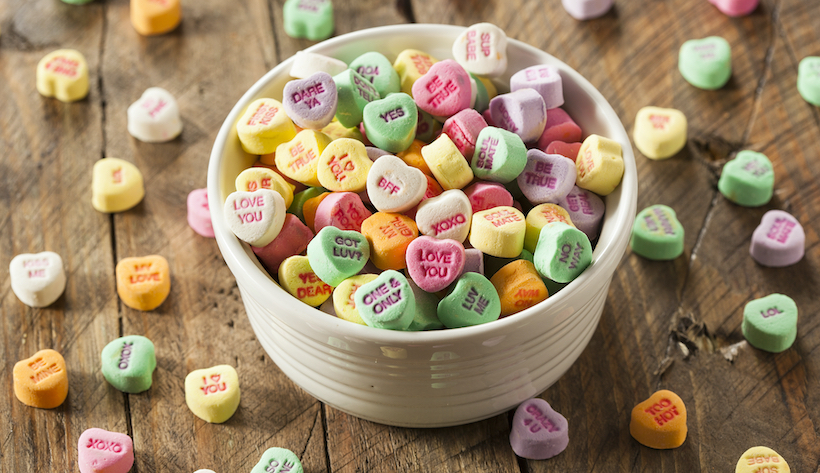
Now, the verdict is still out on whether there are people alive who genuinely love the taste of conversation hearts. (I know I haven't met any.)
The consensus often describes them as "chalky," and many times "tolerable," and only sometimes "good."
For all the argument over their taste, those little boxes disappear from the shelves around the holidays – and make it into our homes.
If you think about it, Valentine's Day isn't the only holiday with a misfit treat. Christmas has fruitcake, Easter has Peeps, and Halloween has candy corn.
However, there is something to be said for the nostalgia these treats bring that trumps the need for their flavor to be something exquisite.
Even if you are not a fan of their taste, conversation hearts are charming. If nothing else, they are an attractive way to decorate baked goods or to make a sweet statement. Conversation hearts have even made their way into pop culture – showing that no matter how much money you have, these inexpensive candies are loved by all.
Here are some times the spotlight was stolen by these little hearts:
• Kim Kardashian launched a 2018 Valentine's Day fragrance in bottles shaped like conversation hearts.
• In 2004, a Michigan resident by the name of Mike Waltz reached out to the candy company for a box of hearts that featured only one message- "Marry Me" to use when he proposed to his girlfriend.
If there is still any doubt in your mind about the continued popularity of these unlikely holiday heroes, let the stats speak for themselves.
• Currently, every year about 8 billion candies are produced to meet demand. That's about 100,000 pounds a day.
• Conversation hearts represent about 40 percent of the candy market during Valentine's Day – falling second only to chocolate.
• During the six weeks before the arrival of Valentine's Day, roughly 13 million pounds are sold.
• The hearts are made for almost 11 months to produce enough for the holiday season. Production for the following year begins shortly after Valentine's Day and continues late into January.
It was one of those things you never wanted to see happen, but the candy giant fell on hard times in the 2000s. NECCO had been experiencing a steady decline in profit since 2003.
Ultimately, NECCO was forced to declare bankruptcy and was then bought out for $17.3 million in May of 2018 by an investment company named Round Hill. Round Hill had a reputation for reviving some dying brands, including Hostess and Chef Boyardee. So, maybe all was not lost?
Round Hill ended up selling NECCO to an anonymous buyer. That buyer then sold the company once again in September to the Spangler Candy Company.
The Spangler Candy Company is an Ohio-based, family-owned confectioner that has been in business since 1906. They are known for their circus peanuts and, most notably, their Dum-Dum lollipops. Spangler is also the only major candy cane producer in the U.SU.S.
The unfortunate effect of all the hand-changing during acquisition was that after having years of consistency, the little heart candies weren't found on the shelves in 2019.
During a press conference, CEO Kirk Vashaw was excited to add the iconic candies along with NECCO wafers to their traditional candy list. However, he also announced that there were improvements to be made and challenges to overcome before relaunching production.
Turn that frown around, though - if you haven't yet heard, Spangler brought back the beloved heart-shaped candies in time for the 2020 Valentine's season.
There were some difficulties, though – and a fair number of those conversation candy hearts lack printing. (Silence is a love language, right?)
Expect a full, printed run of the hearts in time for 2021 Valentine's Day!
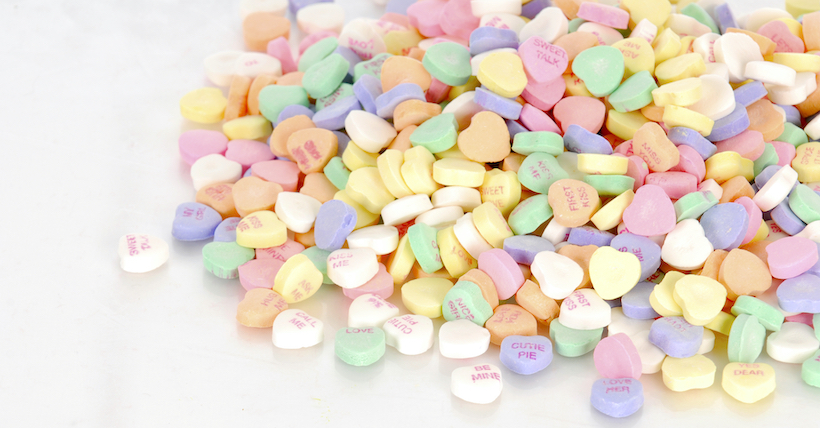
Conversation hearts have enjoyed a fascinating evolution with Valentine's Day in the United States. They've come a long way from lozenges to small candy hearts with emojis on their face.
Pretty neat, right? I'm sure you'll look at those hearts differently the next time you pick up a box.
Given a choice, what message would you like to see?